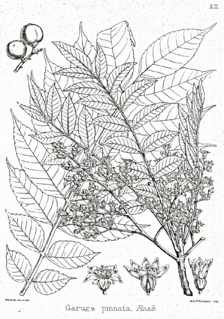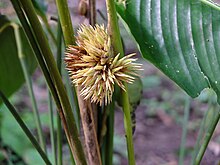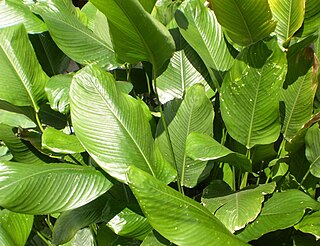
Scaphium affine is a tree species in the family Malvaceae, subfamily Sterculioideae. It is native to mainland Southeast Asia and no subspecies are listed in the Catalogue of Life.

Woodfordia fruticosa is a species of plant in the Lythraceae family. Flower peckers drink nectar from its flowers.

Coelogyne trinervis is a species of orchid. It is native from Indo-China to west and central Malesia.
Canarium album is a tree species in the genus Canarium and the family Burseraceae, found in Indo-China; the Catalogue of Life does not record any sub-species.

Capparis zeylanica is a climbing shrub common in the forests of the Indian subcontinent, Indo-China, China and Malesia; no subspecies are listed in the Catalogue of Life. Several species of Lepidopteran larvae feed on its leaves.

Garuga pinnata is a deciduous tree species from the family Burseraceae.

Protium serratum is a small-medium tree species in the genus Protium and the family Burseraceae. The Catalogue of Life does not record any subspecies.
Trichosanthes baviensis is a climbing plant in the family Cucurbitaceae. No subspecies are listed in the Catalogue of Life. It was described from the Ba Vi area in northern Vietnam and also occurs in southern China.

Sterculia lanceolata is a tree species, belonging to the genus Sterculia and the family Malvaceae. The species can be found in southern China and Vietnam.

Sterculia lanceifolia is a bush/tree species belonging to the genus Sterculia in the family Malvaceae. This species is found in Bangladesh, NE India, China and Indo-China and there are no subspecies listed in the Catalogue of Life.
Phrynium imbricatum is a species of plant in the family Marantaceae. It can be found from India through to most of Indo-China; no subspecies are listed in the Catalogue of Life.

Wrightia religiosa is a species of tree in the family Apocynaceae. Its distribution includes: China (Guangdong), Indochina and Malesia including the Philippines; no subspecies are listed in the Catalogue of Life.

Wrightia pubescens is a species of small tree in the family Apocynaceae. Its distribution includes: Australia, southern China, Taiwan (introduced), Indonesia, New Guinea, Philippines and Indo-China. In Viet Nam, it may be called: lòng mức lông.
Streblus taxoides is a species of plant in the family Moraceae, tribe Moreae. It is a medium-sized, spiny bush found in the sub-canopy layer of Asian tropical forests. This species can be found in India, China, Indo-China and Malesia; no subspecies are listed in the Catalogue of Life.
Stixis scandens is a species of liana in the family Resedaceae and the type species in its genus. No subspecies are listed in the Catalogue of Life. It is found in Indo-China; in Vietnam it may be called quã dây leo.
Harrisonia perforata is a species of liana in the family Rutaceae. It has a recorded distribution includes: Andaman Islands, Nicobar Is., Bangladesh, Myanmar, Indo-China, Java and Lesser Sunda Is., but no subspecies are listed in the Catalogue of Life.

Trachyzulpha is a genus of bush crickets in the subfamily Phaneropterinae, found in China, Indo-China and Malesia. It belongs to the tribe Tylopsini and is the only genus in the subtribe Trachyzulphina Gorochov, 2014.

Artocarpus gomezianus is a tree in the family Moraceae and a wild species on the breadfruit/jackfruit genus (Artocarpus); it may be referred to as the 'sampang' and its Vietnamese name is mít chay. Distribution records are from: Assam, through Indo-China to west Malesia.





















